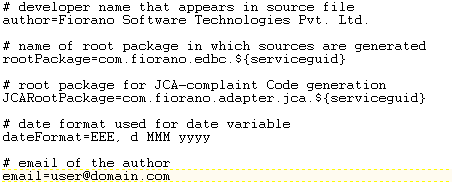Changing Template Settings (Optional step)
In case new variables are not required in the predefined template, skip this section and start from the Defining Microservices section.
Creating a Setting
A setting contains the defined variables that can be used in templates of source files and values that replace these variables during the source generation.
- Each folder in %TEMPLATE_ENGINE%/etc is a setting. The Fiorano setting can be seen in Figure 1 under the Component Launch Semantics section.
A setting typically consists of the following files:
- templates.properties: This is a file containing the variables that can be used in the templates of source files.
- copyright.txt: This is a text file containing the copyright notice that should be included in the generated source files.
To create a new setting,
- Create a directory in %TEMPLATE_ENGINE%\etc with the setting name required.
- Create the files templates.properties and copyright.txt.
- Define appropriate variables in templates.properties.
Variables
The template engine uses variables to substitute values during the code generation.
In-built variables
The following table illustrates in-built variables:
Variable Name | Description |
|---|---|
guid | exact GUID of the service |
serviceGUID | GUID of service with first letter as lowercase |
ServiceGUID | GUID of service with first letter as uppercase |
serviceguid | GUID of service in lowercase |
version | version of the service |
inputPorts | java.util.ArrayList containing input port names |
outputPorts | java.util.ArrayList containing output port names |
inMemoryLaunchable | java.lang.Boolean specifying whether service can be launched in-memory |
isSyncRequestType | java.lang.Boolean specifying whether SyncRequestType is enabled or not for input port |
isBCConnEnabled | java.lang.Boolean specifying whether connection semantics is enabled for a JCA-complaint component |
fioranoHome | Fiorano Platform installation directory |
copyright | copyright notice for source file (as javadoc comment) [ content of copyright.txt from setting directory ] |
Date | current date |
rootDir | root directory to resemble root package |
BCRootDir | root directory to resemble root package for JCA-complaint components |
The values for the above variables either picked up from pre-defined locations or computed based on other variables and hence the user does not have complete control of these variables.
These variables are available independent of the setting being used
Variables Defined in the Fiorano Setting
The following table explains the variables present in the Fiorano Settings:
Variable Name | Description |
|---|---|
rootPackage | Name of the root package in which sources are generated |
JCARootPackage | Root package for JCA-complaint Code generation |
author | Developer name that appears in the source file |
dateFormat | Date format used for date variable |
Defining New Variables
New variables can be defined by adding an entry in the templates.properties file.
This is a java properties file containing:
- The variables defined that can be used in the templates of the source files (present in %TEMPLATE_ENGINE%\<lang>\src).
- The values for the defined variables which is substituted during the source code generation.
A typical file is shown in the figure below.

Figure 1: templates.properties file containing defined variables and their values
To create a new variable with name e-mail and value user@domain.com, edit the templates.properties file as shown in the figure below.

Figure 2: Modified templates.properties file
For more Information regarding editing properties file, see http://java.sun.com/j2se/1.4.2/docs/api/java/util/Properties.html#load(java.io.InputStream)
Modifying the Templates
As shown in Figure 1 under the Creating Custom Microservices section, source file templates for different languages are present at %TEMPLATE_ENGINE%\<lang>\src . These can be edited to use the variables defined in the previous section.
Using the Variables in Template
The variables defined can be referred in the template files by specifying as ${variable_name}. Shown in image:
Figure 3: Source template file showing use of variables
